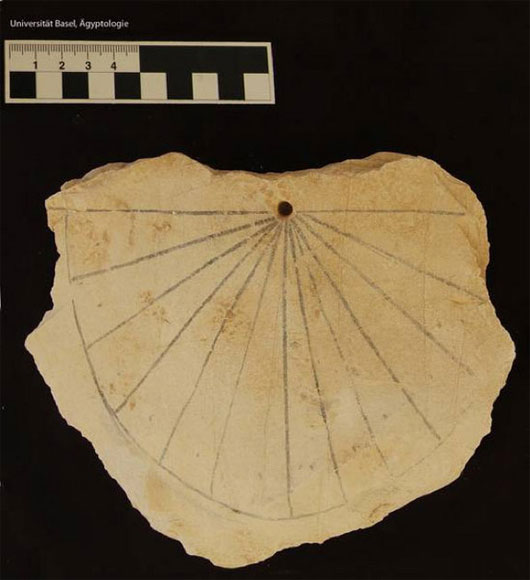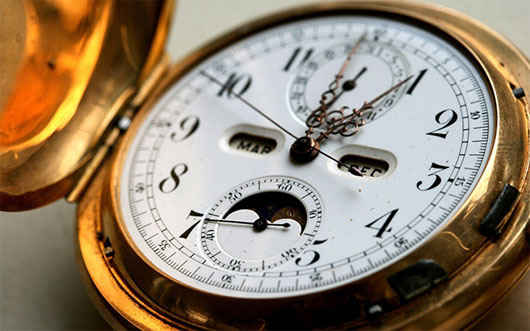Why does 1 hour have 60 minutes, 1 minute has 60 seconds and 1 day has 24 hours?
Today, 60 minutes a day with 24 hours or 1 hour is a very normal convention that everyone knows. So have you ever wondered why 24 is not 25 or 26? The chosen number 60 is not the other ten round numbers like 80 or 100. In this article, we go together to find the answer to the question: why is 1 hour divided into 60 minutes, 1 minute divided into 60 seconds and 1 day with 24 hours?
How did the ancient people calculate the time? Based on the Sun.
Currently, the most widely used numerical system is the decimal system (base 10), a system that according to researchers is derived from making it easy for people to count using finger. However, many early civilizations used binary decimal (base number 12) and hexadecimal (base 60) to divide 1 day into smaller parts.

The ancient Egyptian clock was found when excavated in the Tomb of the Kings dating from 1550 to 1070 BC
Thanks to the documents and evidence found, the researchers confirmed that the ancient Egyptians used the sundial. Historians have come to the conclusion that most of the first civilizations were based on the Sun to divide the time in one day into smaller parts. The first vestiges of the sundial are simply a stick, or stick sticking to the ground. The time is determined by the length and direction of the ball in the sun.
As early as 1500 BC, ancient Egyptians developed quite high-end Sun watches. It is a T-shaped bar placed on the ground. This tool is aligned to divide the interval between dawn and sunset into 12 equal parts. This division reflects the ancient Egyptians who started using the binary decimal system.

According to the researchers, the number 12 is chosen as an important number and is based on the number of cycles of the Moon in 1 year. Another theory to explain the number 12 is because it equals the number of hand burns on each hand (except the thumb). However, the Sun clock method has one drawback: the length of each day varies depending on the color of the year, a sunny day in summer is longer than in winter.
Because there is no artificial light yet, people in this period view the time of light and dark as two opposing realms rather than the components of a complete day as the current convention. When there is no sunlight, calculating the time at night (the interval between the setting sun and growing) is more complex than it is during the day.
However, in the era of using the Sundial, ancient Egyptian astrologers noticed a set of 36 stars dividing the circular sky dome into equal parts. Daytime will be marked by 18 occurrences of 18 stars, 6 stars will be used to mark the time of dawn and dusk. The 24 stars are difficult to observe. And the entire shadow period will be divided into 12 parts corresponding to the remaining 12 stars. The result is that the night is divided into 12 equal parts (a signal of the binary decimal).

The image of the Roman water clock is preserved at the Athenian Agora museum
Until the New Kingdom period in Egypt (1550 to 1070 BC), the aforementioned measurement system was simplified into a set of 24 stars, 12 of which marked night time periods. Next is the appearance of the water meter (clepsydra) used to measure the time at night. This is considered the most accurate timing device in ancient history. Water watches were found at Ammon temple in Karnak, Egypt dating back to 1400 BC. This is a vase with the inner surface studied and the water catcher underneath. Night time will be divided into 12 parts corresponding to the predetermined amount of water. Water clocks with similar operational principles are also found at the remains of ancient Greeks and Babylonians.
Why does 1 hour have 60 minutes? 1 minute has 60 seconds? Why is number 60? Origin name minute (minutes) and second (seconds)?
Since both day and night are divided into 12 parts, the model of 24 hours a day is gradually shaped. However, fixed-length hours were not established until the Greek period, when Greek astrologers began to use this model systematically. and applied as a standard in calculation. In studies from the years 147 to 127 BC, astronomer, mathematician and geography, Hipparchus proposed dividing 1 day into 24 hours based on the time of 12 hours of day and 12 hours of night of the day stool points. However, for many centuries after that, people continued to use different models of hourly lengths each season. And the time period model of 1 hour is fixed only popular in Europe at the beginning of the appearance of mechanical watches in the 14th century.
Hipparchus and other astronomers in Greece applied astronomical techniques developed earlier by Babylonians who settled in Mesopotamia. The Babylonians performed astronomical calculations based on the hexadecimal system (base 60). This is a calculation system inherited from Sumeria people from 2000 BC. So far, there has not been an exact explanation for choosing the number 60. A hypothesis is made for the convenience of expressing division by 60 which is the smallest number that can be divided by 10. , 12, 15, 20 and 30.
Although the hexadecimal system is not widely used in conventional calculations, this system is still used to measure angles, geographical coordinates and time. In fact, the current round clock face has its roots in the system that was born 4,000 years ago by the Babylonians.
The Greek astronomer famous for his nickname beta, Eratosthenes (lived around 276 to 194 BC) used the hexadecimal system to divide a circle into 60 equal parts to form the system. geographical latitude with horizontal lines running through the famous places on Earth at that time. A century later, Hipparchus standardized latitude lines, representing parallel lines to match the shape of the Earth according to the concept of the time. At the same time, he also envisioned the longitude system with 360-degree covered roads running from North to South, from pole to pole.

Mathematician, geographer and astronomer Claudius Ptolemy, who split hours and named minutes and seconds
Then, in the Almagest astronomy (written in 150 AD), the Roman philosopher Claudius Ptolemy explained and extended Hipparchus's previous study by dividing the latitude and longitude 360 system. degree into smaller segments. Each level is divided into 60 parts and named partes minutae primae (or first minute - first minute) or today more simply is minute (minute). Each part is continued to be divided into a second half into 60 smaller parts which he named partes minutae secundae (or Second minute - second minute in English) which is now called second (second) . This rule marks the birth of the so-called minute and second that we still use today.
However, the concept of minutes and seconds has not been widely used daily for centuries following Ptolemy's time. After that, the devices with the clock shape were born but divided into half, one third, one quarter and sometimes divided into 12 parts without dividing into 60 parts. Moreover, contemporaries still do not know that an hour has 60 minutes as it is today. It was not until the end of the 16th century that the appearance of a new mechanical watch included a 1-hour division into 60 minutes on the watch face.
Conclusion

Thanks to ancient civilizations who have sought to identify, track the time that modern society can have a 1-day convention of 24 hours, an hour of 60 minutes, a minute of 60 seconds. At this point, we understand why the second in English is called Second (2nd split). However, advances in science in time have changed the way in which time is determined more and more accurately. In 1967, according to modern physical convention, 1 second was re-defined as the time interval of 9.192.631.770 times the period of electromagnetic radiation emitted by Ce 133 atom when changing the state between the two energy Super delicate bottom . This same regulation opened up a new era of atomic time measurement science and Coordinated Universal Time (UTC).
- The 3-minute rule every day helps you stay healthy all your life
- See the full 11-hour flight only in 4-minute video time-lapse
- Science finds the exact number of hours of sleep every night making you the happiest
- Earth days are shorter than 5 minutes
- The rule of '3 in half a minute, 3 in half an hour' to prevent sudden death
- A day is never 24 hours
- High heels - painful for beauty
- The Earth will have 1 second more on June 30
- 10 mysteries about time (I)
- What to do when your baby cries?
- Impressive figures on Earth Hour 2009
- Filtration technology in 0.5 seconds
 'Fine laughs' - Scary and painful torture in ancient times
'Fine laughs' - Scary and painful torture in ancient times The sequence of numbers 142857 of the Egyptian pyramids is known as the strangest number in the world - Why?
The sequence of numbers 142857 of the Egyptian pyramids is known as the strangest number in the world - Why? History of the iron
History of the iron What is alum?
What is alum?